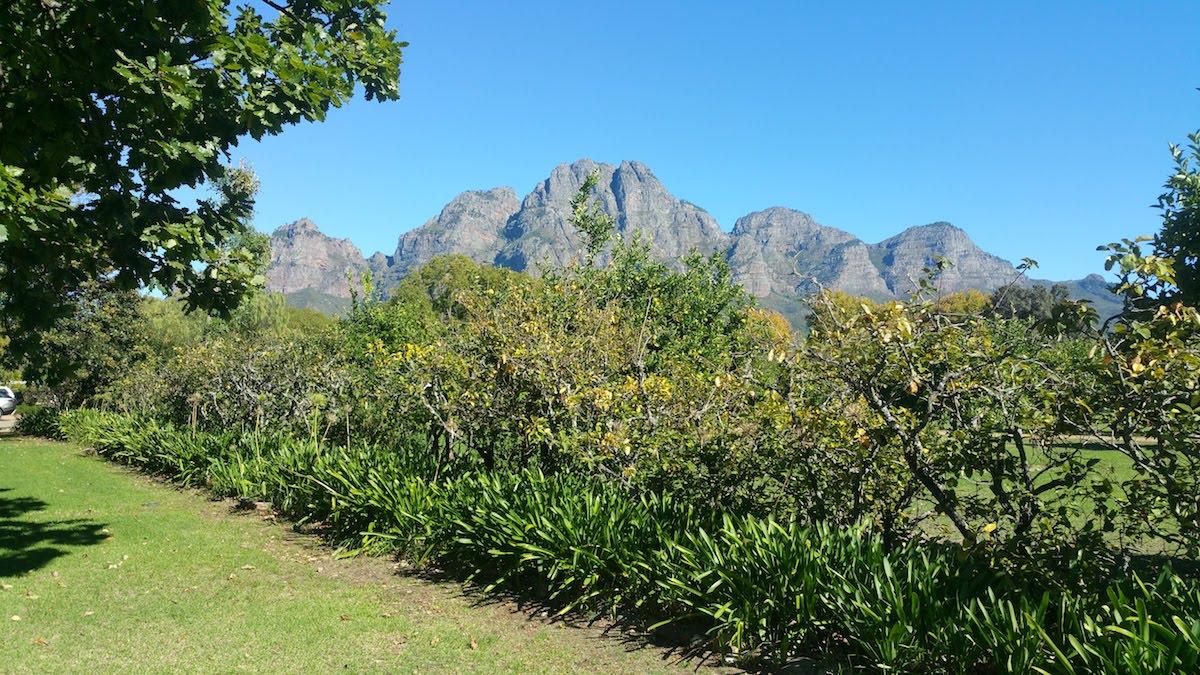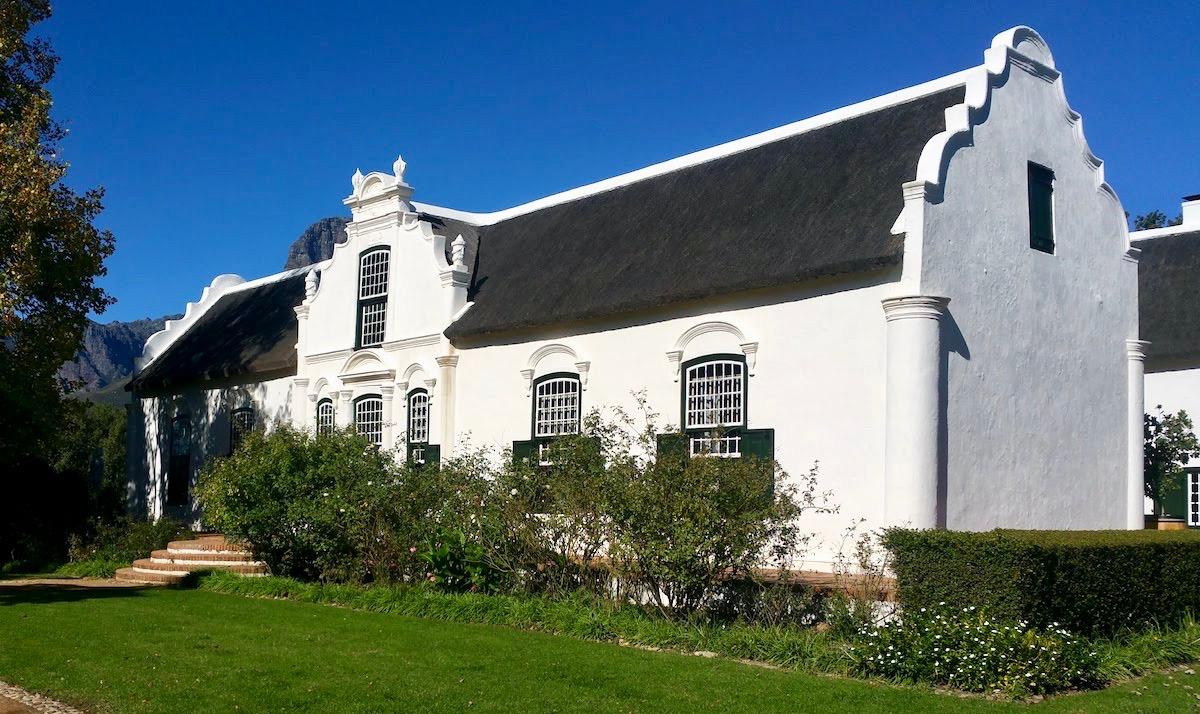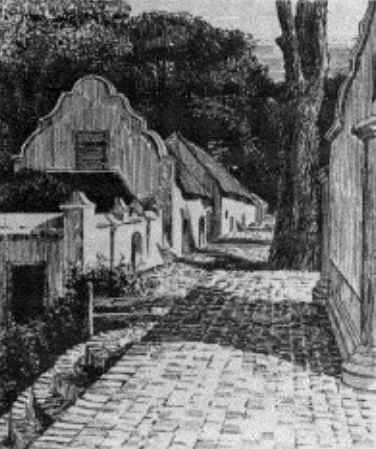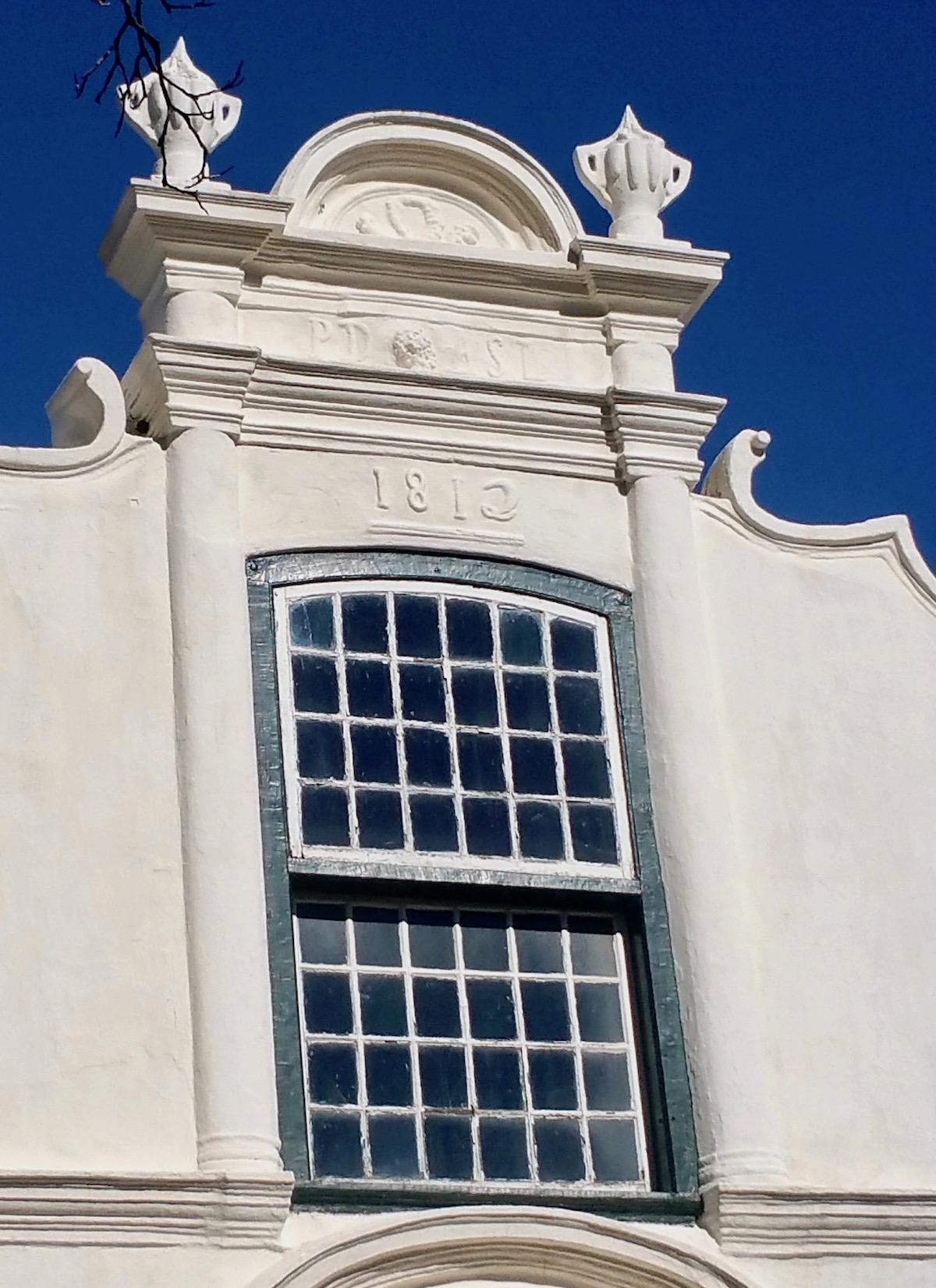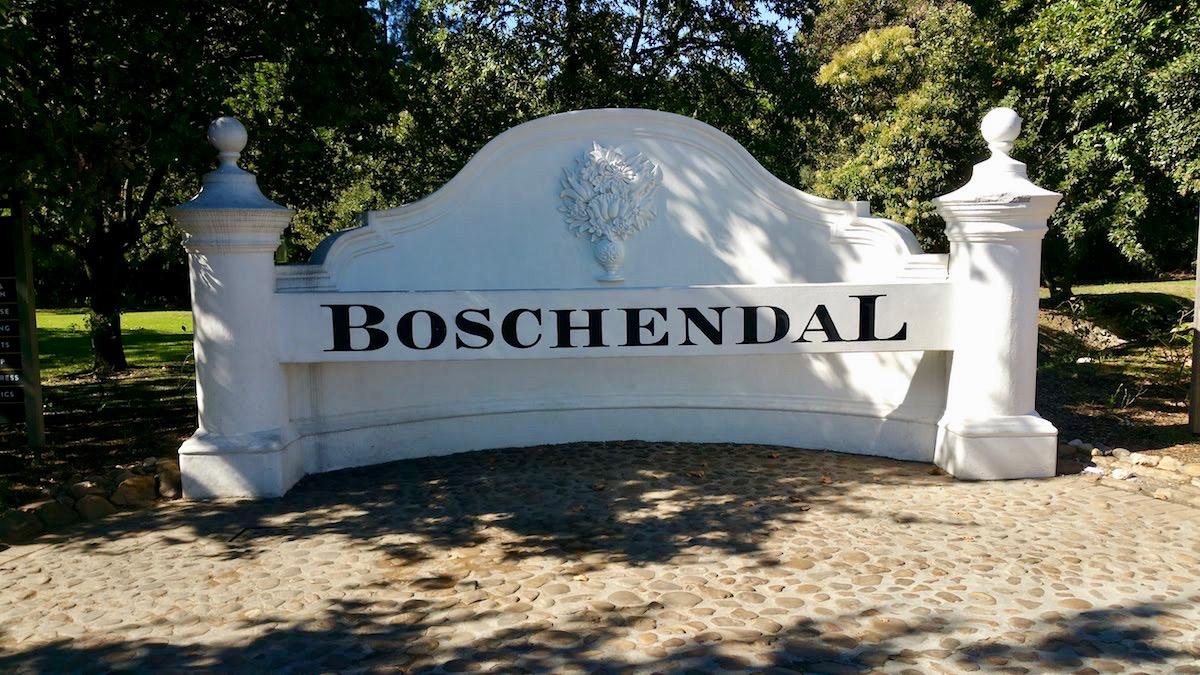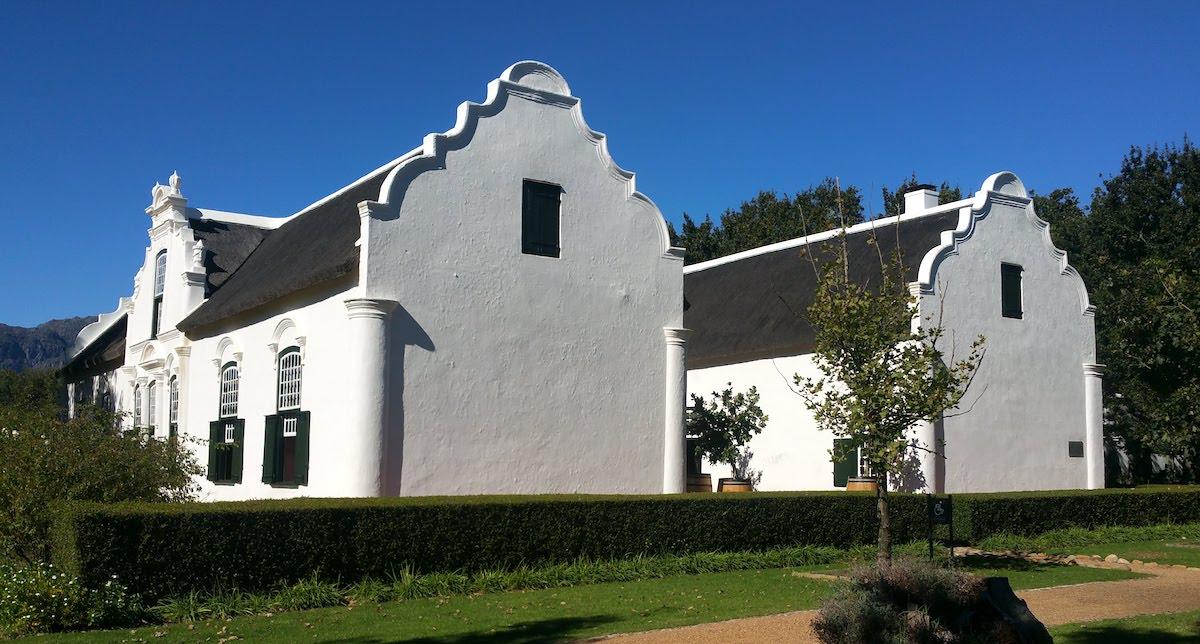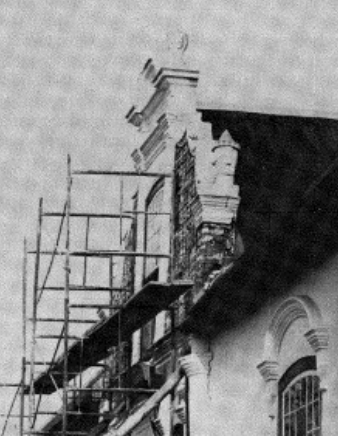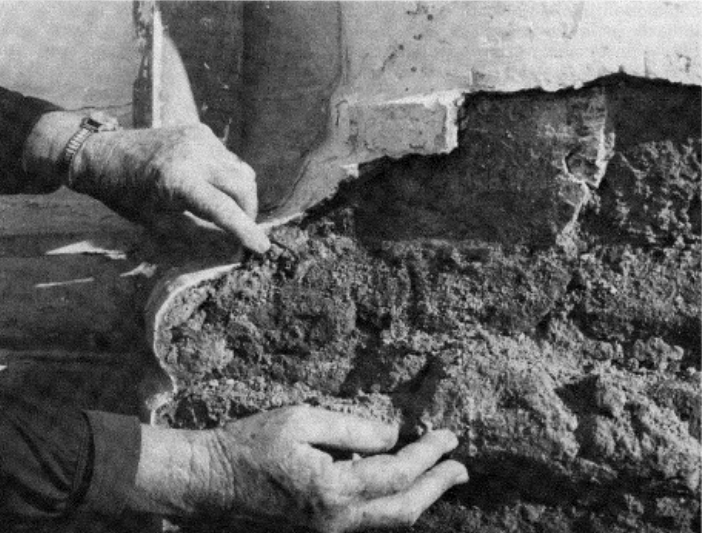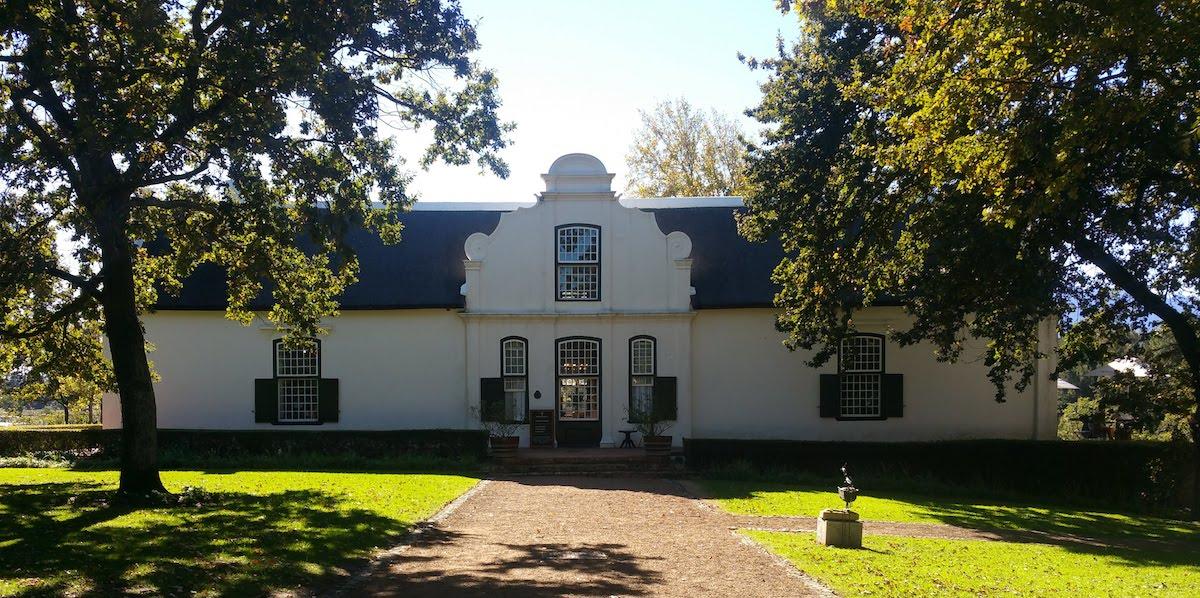
Disclaimer: Any views expressed by individuals and organisations are their own and do not in any way represent the views of The Heritage Portal. If you find any mistakes or historical inaccuracies, please contact the editor.
Below is a superb article on the history and restoration of the famous wine farm Boschendal. It was written by Gwen and Gawie Fagan and appeared in the August 1979 edition of Restorica, the journal of the Simon van der Stel Foundation (today the Heritage Association of South Africa). Thank you to the University of Pretoria (copyright holders) for giving us permission to publish.
Of all the stately farmsteads in the Drakenstein valley, Boschendal has the finest setting. The dark, towering mass of the Drakenstein mountain enhances the whiteness of the homestead's walls and gables and the long, low, stretching line of its ring wall in the foreground. In a more benign way the cultivated landscape confers an undeniable peace and dignity upon the old buildings. Although these were erected in the early 19th century, the cultivation of the land goes back to a more distant time. The original title deed drawn up in 1713 after the 60 morgen had been measured (by officials of the Dutch East India Company which then occupied the Cape of Good Hope) shows that the first owner, the French Huguenot Jean le Long, farmed there from 1685. Le Long named his farm Bossendaal which means 'wood-and-vale'. The governor of the Cape, Simon van der Stel, encouraged all the colonists to plant new trees, especially oaks, wherever indigenous forests were cleared and to this day oaks planted down the years are still an integral part of Boschendal's setting, as they are on many other old Cape farms. With untamed country around them, the early farmers grouped their buildings, with innate sensitivity, into an ordered symmetry, binding them to each other and to cultivated land with linking walls and avenues of oaks.
Boschendal is surrounded by majestic mountains (The Heritage Portal)
It is probably this inter-relationship of homestead, outbuildings, ring wall and landscape that makes Boschendal such a fine example of an architectural style known today as Cape Dutch. Derived from simple vernacular north European pitched roof homesteads, influenced by Mediterranean building practice and the styles of later German and French settlers, this architecture evolved gradually to suit the warm climate and the needs of the hospitable agrarian Cape settlers. The buildings were simple structures for they had to be constructed from materials at hand. Timber came from the surrounding forests. The widths of the rooms, never more than six or seven metres, were determined largely by the lengths of ceiling joists, usually of the beautiful indigenous yellowwood, so that additions to the long buildings could be made only by building wings to form L-shaped, T-shaped or H-shaped structures. Walls were invariably massive, for they were constructed from stone, mud, soft bricks or even rubble. The easily-worked lime plaster, obtained by burning shell at the coast or lime rock inland, allowed plasterers freedom of expression so that mouldings on pilasters, urns, cornices, and decorations on gable faces were plastic and flowing, while embellishments sometimes became quite exuberant. To keep out the rain all surfaces were lime-washed and it is this unifying white which, perhaps more than anything else, captures the admiration of the observer.
A fine example of Cape Dutch Architecture (The Heritage Portal)
History
Boschendal today looks much as it did in the early 19th century for it has been restored as accurately as historical and architectural research would permit. In preparing for the restoration work, the first objective was to unravel the history of the farm and its occupants. All available transfer deeds were examined to establish the names of consecutive owners and in the Cape Archives in Cape Town we delved into wills, mortgages, census forms, slave records, church reports, the minutes of local governing bodies and genealogical details of the families involved. We also studied old photographs, sketches and reports of the many early travellers who visited the valley for descriptions of the farm.
The founders of the De Villiers clan were three Huguenot brothers, Pierre, Abraham and Jacques who, to escape religious persecution after the revocation of the Edict of Nantes in 1685, were forced to leave parents and a younger brother Paul and flee their wine farm at Niort, near La Rochelle in France, for the Netherlands. There they were given free passage to the Cape in the Zion by the Dutch East Indian Company which also provided them with a letter to Simon van der Stel, praising their knowledge of viticulture and commending them to his care. With their fellow refugees, the brothers were received with kindness and compassion. They were supplied with provisions, planks to erect a shelter, given seed and the loan of farming implements before being conveyed to Olifant's Hoek or Elephant's Corner (later to become Fransche Hoek, or French Corner) where many of their compatriots were already settled. The brothers named their communal 60-morgen farm La Rochelle and set to work clearing land which was overgrown with bush and abounding with wild animals. Their farming achievements must have impressed Van der Stel for, five years after their arrival, each brother was granted his own farm, contiguous to one another. Pierre named his farm Bourgogne and settled there with his young wife, Elizabeth, the daughter of Jean Taillefer, who was already producing very good wine from his new vines at the neighbouring farm Normandie. Abraham and Jacques had married the sisters Susanne and Marguerite Gardiol, fellow refugees from Provence, and like Pierre, they planted vines - Abraham at his farm Champagne and Jacques at La Brie.
Inscription on the old National Monuments Council plaque (The Heritage Portal)
By 1716 they had each acquired several slaves, some horses, many cattle and hundreds of sheep. Pierre and Jacques had each planted 10 000 vines and Abraham 20 000. They were making wine and reaping their own corn. Above all, however, between them, they had reared 20 children of whom the eldest were ready to start farming on their own. The brothers looked around for other properties and Abraham's eye fell on Bossendaal where Jean le Long had been farming for the last 30 years, apparently without much success (his son Charles was described in 1719 as a debtor to the company but "poor and not in a position to pay anything"). In 1715 Abraham took transfer of Le Long's grant, together with adjacent unnamed farm land which had been granted to the Frenchman; Nicolas de Lanoy in 1690, retaining the name Bossendaal for the combined property. He was by now prominent in the community; serving as burgher councillor, captain in the burgher cavalry and as a member of the church council. Wine production on two other farms he acquired, Lekkerwyn and Meerrust, was one of the highest in the valley and he had sold Champagne for a good price.
In one respect fortune had treated Abraham unkindly for of his sons, one had died in infancy and the other was a cripple who died young so, two years after buying Bossendaal, he gave his wife, Susanne, power of attorney to transfer the farm to his brother Jacques (Susanne signed the document with a cross). Abraham, who died in 1719, may have found a house built by Jean le Long at Bossendaal but it could hardly have been of a high standard otherwise the value of the combined property would have been greater. Jacques probably built a house when he moved there with his large family, leaving his eldest daughter Susanne and her husband, Pieter Roux, son of the Fransche Hoek sick comforter (teacher), to farm his original property La Brie, but there are no records to say what buildings were on Bossendaal at that time. Jacques had seven slaves, owned 12 000 vines, possessed many cattle and sheep, a few horses and was producing seven to eight leaguers (a leaguer is equivalent to 577 litres) of wine annually and reaping grain for his family and his animals, but as he owned four farms it is not known how much of this applies to Bossendaal, for the farm names are not mentioned in the earliest tax return records.
When Jacques died in 1736, aged 74, Marguerite lived at Bossendaal for three years but when Jan, her youngest son, married she retired to the farm Bakhoven which she had bequeathed to her eldest surviving son, David. Before leaving Bossendaal she gave David general power of attorney and instructed him to transfer the farm to Jan for 5 000 guilders. Jan was also a fine farmer. His training under Jacques must have started at an early age for in tax returns of 1726 we see that Jan, aged nine, already possessed 25 cattle, as well as a hatchet, a sword, a pistol and a gun, referred to as "houwers, degens, pistolen, saphanen". A few years later census records showed he had 30 cattle and by 1730 he owned 100 sheep as well. When grazing in Fransche Hoek became scarce early in the 18th century, farmers could rent loanfarms in the interior annually from the Dutch East India Company. By 1731 Jan's father had acquired the loan of the De Wilge Rivier farm in the untamed country beyond the Hex River, a long trek from his home, and it is conceivable that Jan, perhaps accompanied by a trusted slave, used to take his father's stock to graze there in the winter months.
Jan married Elizabeth, the 17-year-old granddaughter of the Huguenot, Pierre Joubert, in 1738 and a year later she gave birth to their first son, after which she had a child every other year for 24 consecutive years until her death in 1760. The following year Jan, now 45, married the 24-year-old Gertruida du Toit, who also bore a child every second year until she had had ten. Of the 22 children Jan fathered in 44 years four daughters and one son died young and of the 16 that married, eight chose their partners from the De Villiers family.
Jan himself built a house at Bossendaal but it is not certain whether this was a completely new structure or whether, as was common practice in those days, he enlarged and embellished his father's old house, adding a front gable. A sketch of his home with gable dated 1746 was still in possession of the De Villiers family 200 years later in 1946, but unfortunately cannot be traced today. Apart from the fine buildings Jan and his children built, they also contributed largely to the extension of viticulture in the valley.
He died in 1796, aged 79. His widow, Gertruida du Toit, remained at Bossendaal to care for their youngest son Paul and continued to live there even after his marriage to Anna Susanna Louw in 1801. In 1806 Gertruida made a will, bequeathing Bossendaal to Paul for the sum of 40 000 guilders, payable in two instalments - the first three weeks after her death and the second a year later. He received transfer in June 1807, on condition that he would not take possession of the farm until after his mother's death or until she felt inclined to leave. The property Paul acquired had in- creased in value from 5 000 to 40 000 guilders during his father's ownership. Apart from the house which he had completed in 1746, Jan probably had started building the outhouses surrounding the back werf (yard), the quaint henhouse with built-in laying nests; the extensive cellars, the wagonhouse with storerooms, the round threshing floor and the slave-quarters to house his 31 slaves, but whether he completed them all is debatable, as the story of the outbuildings' gables will later reveal.
When restoration work started in 1975 no trace could be found of earlier cellars or outbuildings used by the first two owners. We did, however, uncover the footings of Jan's house, for Paul had built the soft brickwork of his own house on the stone foundations of his father's house, thereby raising the floor level by almost one metre and levelling the surrounding werf. This made his house more imposing when seen from the rear court and expanded the view towards the Drakenstein mountains from the front and side stoeps. The increased floor height meant that the walls were also much drier, for the hollow in which the old house stood was probably very damp in winter. Paul and Anna must have felt great pride when the final plaster decorations were added to the front gable; for together with the date 1812 appear their own initials to show to posterity who the builders had been. At a later stage, the gable depicted the date 1818 but enough evidence has been uncovered to confirm that the house was completed in 1812. Alys Pane Trotter, an Englishwoman who sketched the old Cape farms as she toured the Cape on her bicycle in 1896, gives the date as 1812 in her description of Boschendal. Careful examination of the gable revealed that the old lime plaster figures once had been reformed with cement and whoever had been responsible had been misled into thinking that the figure 2, which had become obscure, was an 8. As we know Paul took transfer in 1807 it is more than likely that his house would have been completed much sooner after that date than 1818.
Stoep at Boschendal sketched by Alys Fane Trotter in 1896
Gable with date and initials (The Heritage Portal)
An inventory in the Cape Archives of the household effects of Paul and Anna provides a description of how the rooms of Bossendaal were furnished early in the 19th century: sofas, easy chairs and dining chairs with horse-hair upholstery, mahogany framed mirrors, a grandfather clock, cabinets with silver inlay, sideboards, paintings with gilded frames, several dining tables, a fourposter and other beds with their drapings; carpets, curtains, copper cuspidors and kettles; a large collection of silverware and cutlery.
At the end of 1839 Paul and Anna moved to the Paarl, transferring Bossendaal jointly to their two sons, Jan Jacobus, then 35, and Hendrik Francois, who was only 17 and newly married. Each had to pay £1 250 for his half-share, but after three years of farming with his brother, Hendrik obtained a private bond of £1 000 for which his father and father-in-law stood security, enabling him to buy his brother's half-share and become sole owner in 1843 of Bossendaal. The property still included the two original grants of 60 morgen each, but now more than 80 morgen of adjacent quitrent land granted to Paul in 1810 had been added to the transfer.
Hendrik Francois farmed at Bossendaal for close on 20 years until ill health forced him to resell the property to Jan Jacobus in September, 1860. Hendrik's last days were spent in Cape Town, where he died, aged 38. In the transfer document of this transaction, for the first time a name is given to each one of the original two grants - the one Boschendaal, now spelt with a 'ch', and the other Champagne.
Many stories are told about Jan Jacobus, nicknamed Jan Paul, the last De Villiers to own Boschendaal - stories of a true gentleman who always exacted meticulous service and attention from his staff; of his exotic dressing gown made of eastern material and his knitted nightcap with tassel; of his large family gatherings where the entertainment lasted for three days; and of the receptions for Sir George Grey, the governor of the Cape (which by then was under British rule), who always stayed at Boschendaal when visiting the Groot Drakenstein area. Jan Jacobus was also a keen horse breeder and had some of the best horses in the district. One night, when he heard a commotion in the stables, he went out into the cold to investigate and contracted pneumonia which, according to a granddaughter, eventually caused his death in 1880. It was probably this illness which had prompted him to sell the farm in 1879 and move to the Paarl. He gave the new owner, Daniel Jacobus Retief, a bond of £3 000, the selling price being £3 700. Retief went insolvent seven years later and sold at half the price he had paid to J GC Myburgh. Ten years later, when Cecil John Rhodes started buying farms in the Drakenstein valley, Boschendal (now spelt with a single 'a') was sold to his agent Lewis Lloyd Michell, and was then almost immediately transferred to Rhodes' ownership, to become part of the Rhodes Fruit Farms.
Entrance to Boschendal today (The Heritage Portal)
Restoration
When it came to planning the renovations, we were pleasantly surprised to discover how little the H-shaped house had been changed since its completion in 1812. Even those departures from the traditional Cape Dutch plan, which at first we attributed to subsequent changes, proved on closer examination to be design peculiarities instituted by Paul or more modern additions that could be easily removed. For example, two small rooms built at the back of the agterkamer (dining-hall) seemed atypically situated. When the walls were stripped of plaster they were found to be tied into the outside walls; moreover, the direction of the yellowwood ceiling beams in these rooms confirmed that they had been planned and built as part of the original design- one probably for use as a pantry, the other as a small extra bedroom. A beautiful teak and yellowwood wall cupboard found built into the wall of a back room instead of a prominent position in a front room, as is customary in Cape Dutch homes, also aroused suspicions of building alterations, but these were allayed when plaster stripping revealed a relieving arch above the cupboard: there was no sign of the surrounding brickwork having been disturbed. Possibly Paul, when he built his house, preferred to install a grand, wooden screen between the hall and the dining-room and moved the wall cupboard, the showpiece of his father's home, to its presentposition. Certainly the magnificent teak and yellowwood folding screen, with its fanciful inlay and adjustable louvres, is one of the finest in the valley. It had been carefully designed and well made and, apart from small defects in the iron-mongery, is still in excellent condition. But a brick fireplace which had been added in the agterkamer in the 1930's seriously impaired the setting required for such an ornate screen, and it was decided to make provision for electrical heating and have the fireplace removed. All dividing walls were examined to establish Paul's original ground plan. It was found that two interior walls had been added some time after the completion of the house: one dividing the kitchen created a rather useless small passage to the pantry behind the hearth and the kitchen undoubtedly would be better without it; the other, dividing the voorkamer (front room) to the right of the entrance hall, partly obscured a front window-reveal so that the window was uncomfortably squashed into the end room. When this was removed, the reception room assumed its original generous proportions; exposed at the same time on the underlying plaster was the original dark blue-green wall paint with a pattern of hand-painted friezes around the window reveal.
The architects were surprised to discover how little the H-shaped house had been changed
This exciting find led to a careful examination of all original wall colours and the discovery that the voorkamer, agterkamer and reception room had all been painted dark green, whereas the bedrooms were originally painted a warm beige or light olive. Decorations, delicately drawn by some unknown craftsman for Paul de Villiers, were discovered in all these rooms. The patterns varied, one consisting of twining pink roses, another of black acorns with small green leaves and yet another of stylised orange and black fruit on a bright ochre background. When the overlay of paint was carefully removed, the patterns were found to form friezes at window sill height, round door and window openings and below the ceiling beams.
Once the original ground plan of the house was established, a further examination of the interior revealed few serious defects. Walls were firm and upright with only a few cracks and patches in the old lime plaster. The heavy yellowwood ceiling joists, neatly squared and finished with mouldings, supported at regular intervals broad hand-sawn yellowwood ceiling boards, all in perfect condition. Although similar floorboards, by now much worn, had been laid on oak joists directly embedded into the soil, they needed replacing only in areas where wood borer had bern overactive. The inside doors, teak framed with yellowwood panels, were of two patterns. Did Paul perhaps re-use the doors from the house of his father, Jan? Hand-made iron hinges and intricate yellowwood architraves had not suffered damage over the years but the old mortice locks had given way. They were all repaired and fitted with specially-made brass escutcheons according to existing patterns. Boschendal's front and backdoors are typical of many old Cape farmhouses, with upper and lower side-hung opening sections and large fanlights. From behind these fanlights glazed sections slide down to form windows when the top parts of the doors are opened. A similar door-cum-window from the agterkamer on to the left side-court provides a breathtaking view across the orchards to the distant Drakenstein mountains. Missing wooden and glass sections in these three doors each needed replacement.
The restoration of the interior therefore presented few problems and the original plan proved readily adoptable to present needs. It was decided to build two small and unobtrusive bathrooms en suite into the end rooms, and toilets in the small room off the agterkamer for visitors. The old pantry was re-designed as a compact modern kitchen which could be used to prepare refreshments for people attending board meetings and for small select dinners, so leaving the old kitchen with its open hearth to be furnished as in Paul's time, with simple tables, chairs, benches and old copper and iron kitchen utensils. (Clay floors, smeared with dung once a week, were common at the Cape till the end of the 19th century and even in the grander houses kitchen floors were usually of clay, but in restoration the kitchen has been tiled).
The original pattern of the hearth was later obscured by iron and electric stoves and when these were removed and all later brickwork carefully broken away the old lime plaster surfaces emerged. This suggested that in Paul's day the hearth must have consisted of a higher platform to the left and below the baking oven door and a lower platform to the right, probably for open fire cooking. Between the two platforms was a space probably used for wood storage.
When we looked again at the initials of Anna and Paul on the front gable we wondered who had designed the heavy mouldings and rather crude urns. Although, for one-and-a-half centuries this gable had withstood the effects of wind and rain, an alarming bulge in the brickwork to the right and above the front door and cracks in the gable face had developed and pointed to the dangerous disintegration of the supporting wall which obviously required urgent attention if the gable was to be saved. Preliminary sketches drawn up by David Beyer, our consulting engineer, were discussed on site with the builder, Rino Brochetto - the biggest problem was how to apply the necessary strengthening mesh and ties on the face of the gable without removing all the stucco mouldings. A step-by-step plan of action was drawn up to strengthen the front and back gable walls internally and externally with mesh applied to the undecorated surfaces; to install cross ties; cut away plasterwork over the worst part of the bulge, underpin and remove all loose brickwork; jack the protruding part of the wall back so that the front door and window on the right side would be less out of plumb and repair the front brickwork, including refixing the sections of mouldings which had been carefully removed. This was a lengthy process, for between each step the brickwork and cement grout had to harden and because the builder was justifiably anxious, he preferred to have architect and engineer present at each crucial step. All were relieved when the final brickwork was completed and the gable pronounced safe.
Dangerous disintegration was halted after step-by-step repair programme. Strengthening mesh and tie rods were placed unobtrusively in undecorated areas. (G Fagan)
Other plasterwork, altered as builders down the years added their bit, also had to be removed. For example, after plaster had been broken away in the rather heavy round bases of the corner pilasters the underlying old lime plaster surface and brickwork indicated that these originally had been much finer in execution with squared-off corners. In fact, a heavy hand had slapped extra cement on all the base mouldings that ran round the house and had even added mouldings where previously Paul had taken the walls straight down to the surface of the stoep. Before restoration this stoep had been surfaced largely with 23 by 23 cm red tiles with rather a hardlooking finish. However, a patch of older tiles which had been laid before the front door suggested that the original stoep surface had been of smaller tiles of a softer brick colour, a supposition that is borne out by one of Alys Trotter's Boschendal sketches and by a photograph taken shortly after 1900 by the photographer Arthur Elliott. Fortunately a potter was found who was prepared to bake replicas. We guessed that the original tiles probably had been baked on the premises, for according to Karel Luries, an old farm labourer still living on the property, clay bricks for the buildings of labourers' cottages were being fired on the farm during the late 19th century.
Old lime plaster and original 19th century moulding of corner pilasters (G Fagan)
In 1823 Paul made 102 leaguers of wine at the Boschendal cellars and distilled five-and-a-half leaguers of brandy in the kettle under the oak trees beside the river. Every year Paul cultivated more land and planted more vines. By 1830 when his sons had taken transfer of Boschendal, there were 140 000 and ten years later 150 000 vines and they were then producing 110 to 120 leaguers of wine annually. Paul's old cellar, which RFF had used as a store and offices, had long since had its thatched roof replaced with corrugated iron and in this process eaves had been raised and the end gables altered to accommodate the gentler pitch of the iron roofing. The massive 300 by 300mm oak ceiling beams which were common to all the outbuildings, had rotted in the walls. These beams had probably been cut by Paul from the oak forests planted by his grandfather, Jacques. It proved impossible to procure oak beams of the size and quantity needed so we decided to use poplars, felled and trimmed on the RFF estate, as these were plentiful in country districts by 1800 and were often used for roof timbering.
The ceiling installed by Paul no longer existed and there were no records describing what he had used. In all probability it was made of Amndo donax (Spanish reed) which had been imported before 1700 and which was growing profusely on most farms by 1800. These were commonly used for 'rietplafonne' or reed ceilings and it seemed logical to use this material in the outbuildings again.
Once the iron roof was removed, the eaves were lowered and the end gables rebuilt according to an early sketch by Alys Fane Trotter. The thatched roof was then reconstructed to a pitch indicated by old thatch-line impressions found in the lime plaster at the rear of the central gable. The external plaster which needed replacement was stripped and the positions and dimensions of original doors and windows measured in the stone, mud and soft-baked brick walls. New frames for these, copied from an old window and a door that fortunately had been left in the cellar's south wall, were constructed from sound portions of the old oak beam. Hand-wrought iron hinges were copied from the many exist-
ing examples. The long, cool rooms with the handsome heavy poplar ceiling beams and 'rietplafonne' have now regained their pleasing proportions and airy atmosphere and will be used by RFF as a restaurant or for large receptions. A kitchen and cloak-rooms built inconspicuously at the rear of the cellar have been the only additions flowing from the restoration.
The long building on the right side of the court which 'mirrored' the cellar wing had obviously been the coach house where Paul had kept his six wagons and two coaches. Here, too, were the two stables with wooden cribs where his seven horses were obviously tied at night by his coachman, Adriaan. Although signs of the old cribs in Adriaan's stables had long since vanished, documents show that they were still being used to tether mules before Rhodes Fruit Farms acquired tractors for ploughing in 1913. The restoration of the coach house followed much the same procedure as that of the cellar.
The repair of the gables over the cellar and the coach house presented problems of a different sort. Both were found to be incomplete. A possible solution lies in the census returns of damage caused by severe storms of 1822: Paul recorded that at Bossendaal two cellar gables had been damaged and the wall of a building under construction had collapsed. In the coach house, only part of the original centre gable remained but four pilasters and a string course moulding matched those of the incomplete cellar gable, thus lending support to the assumption that these two gables had been identical. By contrast, the moulding of the house gables were heavier and the gable outlines more ornate, so that house and outbuildings clearly were the work of more than one person. We concluded that Jan de Villiers had probably built the coach house and perhaps part of the cellar before his death in 1796 and that Paul had eventually completed the cellar by 1802, duplicating the gable of his father's coach house. The gables on Paul's home were built to the typical early 19th century De Villiers design, with four pilasters, a second moulding below the cornice, but with a semicircular pediment quite unlike other De Villiers gables, where pediments always seemed to be triangular. A study of these De Villiers gables on other buildings in the vicinity helped us to reconstruct the design of the incomplete gables; it is interesting to find that these now very closely resemble the cellar gables at L'Ormarin, once the farm of Jan's cousin, Johannes de Villiers.
The slave quarters and the high stone kraal walls connecting them to the coach house were the last to be restored. The construction of the kraals was probably completed by Paul's sons, particularly that lover of fine horses, Jan Jacobus, the last De Villiers owner of Boschendal. On the werf side, walls had been replaced by concrete piers and diamond mesh gates, but fortunately the old farm employee, Karel Luries, was able to describe clearly how the original walls, with the wooden gates and long cribs used to look, so that these could be reconstructed. After removal of later subdividing walls in the slave quarter's, the original interior plan could easily be adapted into one large and two smaller flats. At the same time the old door and window openings which had been bricked up to provide alternative access from the rear of the building were once again opened onto the werf. The three access avenues have now been lined with newly planted oaks and a garden, hedged by pomegranate, quince, and bay, is being created. Here visitors will be able to see growing examples of early Cape fruit trees, roses grown by the settlers in the early 19th century, as well as the flowers and herbs commonly found in their gardens.
Young oaks line the approach to the restored Boschendal circa late 1970s (Optima)
The number of Cape Dutch homesteads is dwindling, protected as they are only by a regular coat of limewash and so, as the new oaks at Boschendal mature and broaden their shadows over the mellowing walls of the old homestead and as we move further and further away in time from the era of those early farmers, we believe the value of this conservation will grow and enjoyment and appreciation of this beautiful architecture will widen. There is great reward for those involved in conserving this heritage; the rewards will be even greater for those who pass through Boschendal and linger not only to assimilate the rich atmosphere redolent of a past recaptured, but to evaluate the present through his insight into an earlier way of life.
Comments will load below. If for any reason none appear click here for some troubleshooting tips. If you would like to post a comment and need instructions click here.

